You can create natural musk fragrances at home using botanical alternatives like ambrette seeds, musk mallow, and angelica root. Start with basic equipment including beakers, pipettes, and a precision scale to measure your ingredients carefully. Combine 3 parts ambrette seed CO2 with sandalwood, benzoin, vetiver, and labdanum to achieve that signature musky warmth. Understanding proper extraction methods and safety guidelines will help you master the art of botanical musk creation.
Understanding Botanical Musk Components
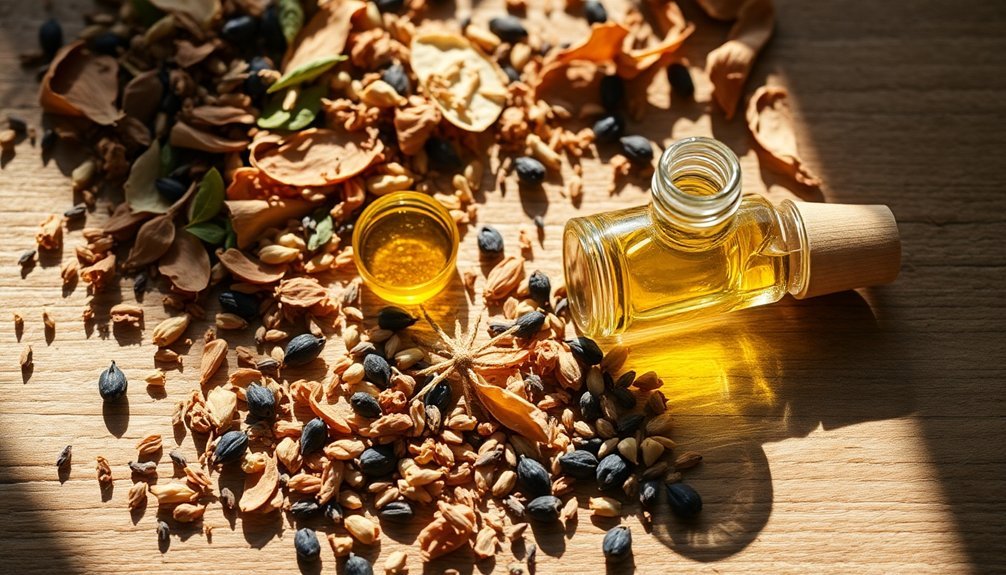
Nature's ingenuity offers several plant-based alternatives to traditional animal musk.
You'll find that ambrette seeds from the hibiscus plant deliver a sweet, floral musk quality, while musk mallow seeds provide a softer, powdery aspect.
Angelica root contains macrocyclic compounds remarkably similar to those found in musk deer.
When working with botanical musks, you'll notice their distinct characteristics.
They're typically fruity and floral, with earthy undertones reminiscent of carrots and pepper.
Unlike animal-derived musks, these plant-based options offer a clean botanical-animalic effect that's less intense but equally compelling.
You can expect a pleasant vegetal sweetness that aligns perfectly with modern clean beauty standards.
These natural alternatives provide consistent scent profiles while maintaining ethical and sustainable practices.
Modern perfumery often combines these botanical sources with other ingredients to create dimensional scent profiles.
Essential Tools and Equipment for Musk Creation
You'll need a solid foundation of basic equipment, including beakers, pipettes, and precision scales, to begin creating botanical musk substitutes.
A mortar and pestle combined with measuring flasks will help you achieve consistent results when working with ambrette seeds and other raw botanicals. Like the innovative approach seen in Tesla's sustainable design, your workspace should prioritize efficiency and eco-friendly practices.
For advanced extraction processes, you'll require specialized tools like distillation apparatus and proper safety equipment such as gloves, goggles, and a ventilation system.
Basic Equipment Setup
Professional perfumery requires a well-equipped workspace with precise tools and instruments to create botanical musk substitutes.
You'll need a digital scale with 0.001g precision for accurate measurements and an analytical balance for the most delicate ingredients. Keep glass beakers and bottles ready for mixing and storing your blends.
For handling materials, you'll want glass stirring rods, metal spatulas, and pipettes. Don't forget protective gear like gloves and safety glasses.
You'll also need fragrance blotters and scent strips to evaluate your creations. Set up your workspace with filter paper and funnels to remove any particles from your concentrates.
Keep a notebook handy to record your recipes and observations. Remember to label all your bottles clearly to track different blends and ingredients. Choosing natural Ambrette seeds provides a sustainable alternative to synthetic musks while ensuring your creations remain eco-friendly.
Advanced Extraction Tools
For successful botanical musk creation, advanced extraction tools are critical to capture and preserve delicate aromatic compounds.
You'll need a steam distillation system, which uses steam to extract oils while producing beneficial hydrosol as a co-product. A vacuum low-temperature extractor, made of stainless steel, helps prevent aroma loss during the process.
Your setup should include an evaporator and condenser working together to separate and collect liquid components while maintaining the original fragrance.
Don't forget the oil-liquid separator to concentrate your fragrances and a medicine liquid pump connected to your control panel for precise pressure control.
A weighing net helps you measure raw materials accurately, while a foam breaker guarantees smooth extraction by eliminating protein-based foam from plant materials.
Sourcing Quality Botanical Ingredients

When creating natural musk substitutes, sourcing high-quality botanical ingredients forms the foundation of successful home perfumery.
You'll want to focus on obtaining authentic ambrette seeds, labdanum oil, and angelica root, which provide the core musky notes for your blend. Choose certified organic suppliers who can verify their sustainable harvesting practices.
- Sweet, nutty ambrette seeds releasing their delicate aroma during extraction
- Rich, amber-colored labdanum oil slowly dripping from the distillation process
- Fresh angelica root with its earthy, musky undertones
- Golden sandalwood oil adding warmth and depth
- Deep green vetiver roots imparting their distinctive woody notes
Partner with suppliers who offer detailed documentation about their sourcing methods and can provide small batch samples for testing.
This guarantees you'll create authentic, high-quality musk substitutes while supporting ethical harvesting practices.
Basic Extraction Methods for Home Perfumers
The art of extracting fragrant compounds requires understanding several key methods available to home perfumers.
For delicate floral materials, you'll find enfleurage particularly effective, though time-consuming. This traditional method uses fats to capture volatile compounds from fresh petals, resulting in intense fragrances.
Steam distillation offers a solvent-free approach that's ideal for creating natural essential oils while preserving aromatic compounds. You'll also get beneficial hydrosols as a by-product.
For heat-sensitive materials, solvent extraction using alcohol or hexane can yield concentrated absolutes and useful by-products like floral waxes.
While CO2 extraction isn't typically accessible for home use, understanding its principles helps you appreciate why certain commercial extracts carry premium prices and offer superior scent profiles that closely match their natural sources.
Creating Your First Ambrette Seed Base
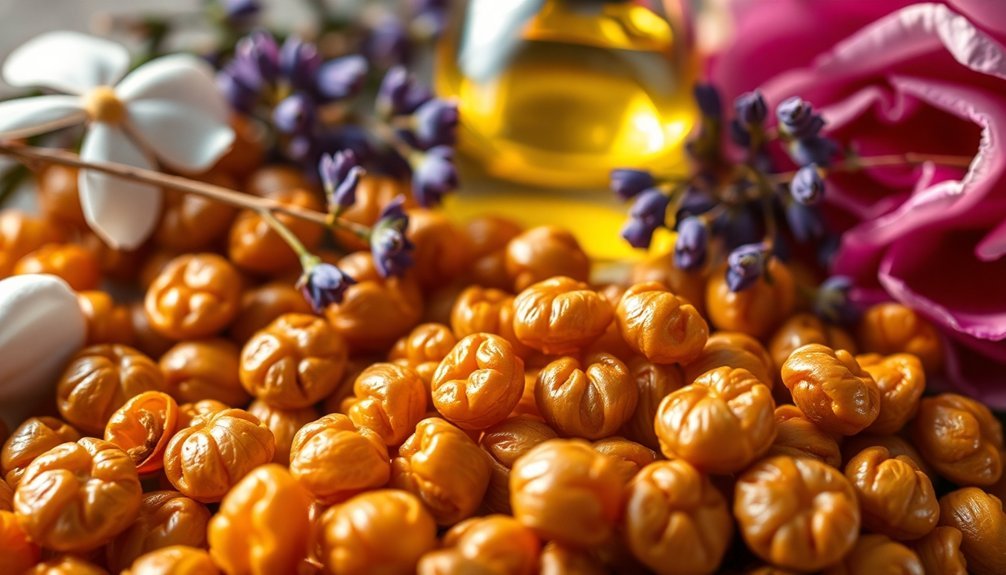
Because ambrette seeds offer one of nature's finest musk substitutes, creating your first ambrette base requires careful attention to both material selection and extraction timing.
You'll notice the seeds develop complex notes as they age, making timing essential for achieving the desired aroma profile.
When working with ambrette seeds, visualize these sensory characteristics:
- Rich, warm musky base with subtle fatty undertones
- Sweet brandy-like notes reminiscent of aged Cognac
- Delicate floral facets that mirror fresh iris petals
- Fruit-forward elements of ripe pear and plum
- Deep tobacco nuances that emerge during aging
Start with small batches, as the oil yield is quite low at 0.2-0.6%.
While CO2 extraction gives the best results, you can begin with simple distillation methods, removing any palmitic acid residue for a cleaner absolute.
Blending Complementary Natural Elements
Building upon your ambrette seed foundation, you'll need to select complementary botanicals that enhance and amplify its musky characteristics.
Start by adding labdanum for deep, resinous notes and vetiver to introduce earthy undertones. These ingredients work synergistically with ambrette's natural musk profile.
For additional complexity, blend in sandalwood and jasmine sambac oils. Sandalwood provides smooth, woody notes while jasmine adds sensual, floral dimensions.
Consider incorporating angelica root oil, which contains natural macrocyclic musk compounds similar to deer musk.
To guarantee proper diffusion, create tinctures of your key ingredients. Mix vanilla bean tincture to enhance sweetness and improve overall diffusiveness.
Remember to maintain balance by incorporating lighter top notes like citrus and avoiding excessive use of benzoin, which can dull your blend.
Achieving the Perfect Musk Accord
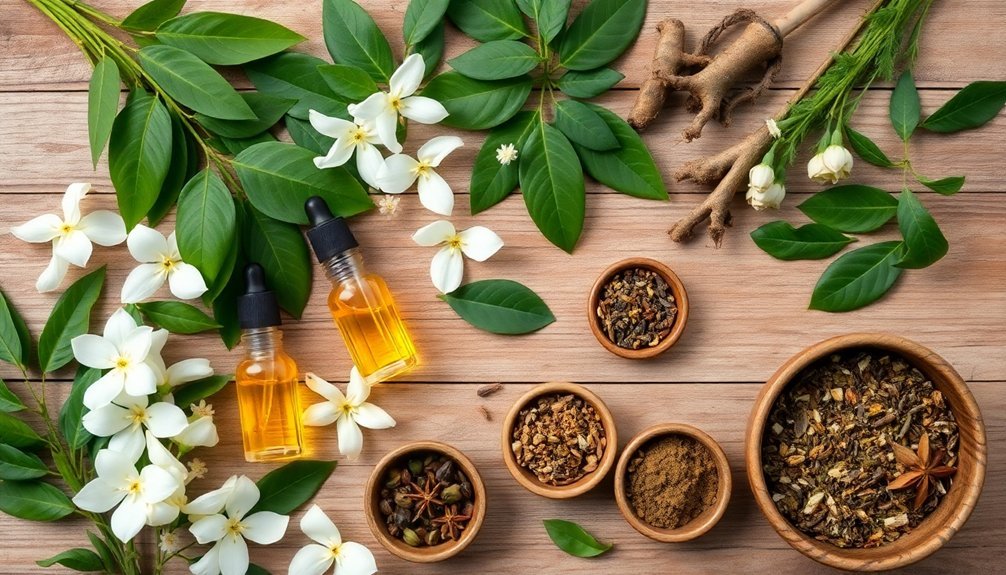
Creating an authentic musk accord requires careful attention to botanical proportions and layering techniques.
You'll need to blend your ingredients thoughtfully, starting with ambrette seed CO2 as your foundation. Balance this with sandalwood and benzoin essential oils, while incorporating vetiver CO2 for earthiness and angelica root CO2 for freshness.
- Combine 3 parts ambrette seed CO2 with 2 parts sandalwood EO for a rich, creamy base
- Layer in 1 part benzoin EO to add sweet, ambery depth
- Add 1.5 parts vetiver CO2 for grounding earthiness
- Include 1 part angelica root CO2 for herbal freshness
- Finish with 0.5 parts labdanum absolute for resinous warmth
Dilute your final accord to 10% in ethanol, then test and adjust until you've achieved your desired musk profile.
Storage and Aging Requirements
Proper storage and aging are critical to developing rich, complex botanical musk aromas.
You'll want to store your raw musk grains in sealed glass bottles in the freezer to maintain their freshness. Don't let them dry out completely, as this can weaken their aromatic properties.
For macerating your musk, choose high-quality carrier liquids like sandalwood oil, which improves with age. You can also use moringa oil or fractionated coconut oil.
Keep your macerating mixture in a dark, cool place, and be patient – sandalwood oil macerations need at least a year to develop. If you're using alcohol for tincturing, remember it won't improve as much with age.
Monitor your mixture regularly and verify your containers stay tightly sealed to protect against air and light exposure.
Safety Guidelines for Natural Ingredients

While natural ingredients can provide beautiful aromatic profiles, they require careful handling to ascertain safe use in perfumery.
You'll need to be especially mindful of concentrated botanical ingredients like oakmoss, rose absolute, jasmine, and ylang ylang, which can cause skin sensitization. Always perform patch tests before applying any new fragrance creation to larger skin areas.
- Keep pre-diluted ingredients in your workspace to minimize toxicity risks
- Store all flammable alcohol-based formulations away from heat sources
- Apply fragrances to a scarf or handkerchief if you have sensitive skin
- Test new blends on a small patch of skin for 24 hours before full use
- Document all ingredients used, particularly those known to be common allergens
Following IFRA guidelines, even though they're not mandatory in the US, will help ascertain your creations are safe for use.
Measuring and Documentation Techniques
Successful perfume formulation relies on three essential measurement and documentation practices: precise weighing, consistent record-keeping, and systematic analysis.
You'll need a scale that measures down to 0.001 grams for accurate ingredient portions. Don't rely on drops, as they vary between liquids. Instead, use disposable pipettes for precise additions.
Keep detailed records of your formulations in spreadsheets, including ingredient ratios and IFRA compliance checks.
When analyzing your musk substitutes, dilute raw materials to 10-20% in alcohol before testing. Use scent strips for evaluation, and wait for the alcohol to evaporate before appraising the fragrance.
Store your blends in dark glass containers, and organize your materials into clear categories: naturals, synthetics, and bases. Label everything meticulously, and maintain sample vials for future reference.
Scaling Your Botanical Formulations
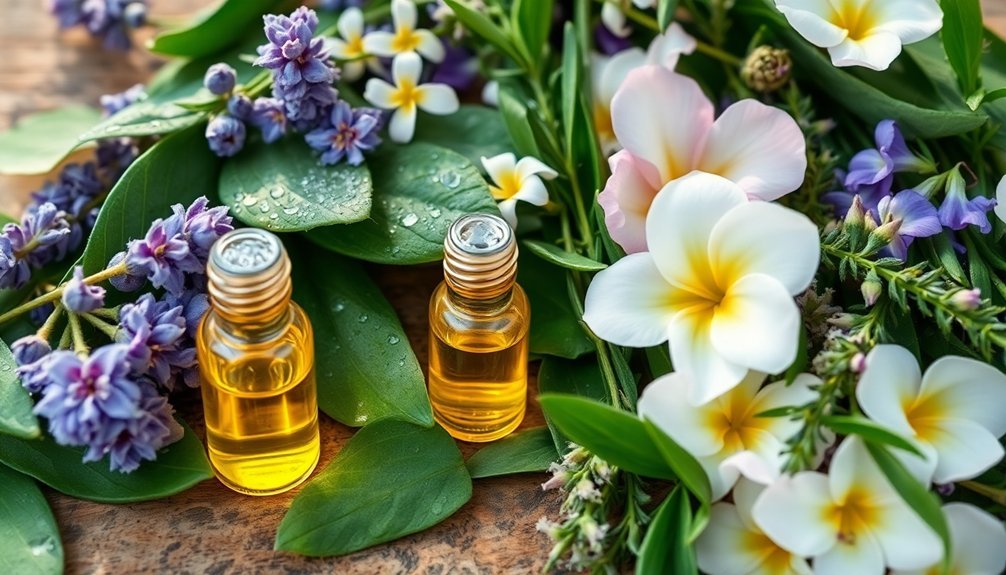
When you're ready to scale up your botanical musk formulations, you'll need to convert your recipe from drops to precise weight measurements using an accurate scale.
You'll want to maintain detailed batch records that include dilution ratios, storage conditions, and any adjustments made during the scaling process.
Your documentation should track both the original small-batch formula and its larger production counterpart to guarantee consistency across different batch sizes.
Measuring For Large Batches
As you progress from small experimental batches to larger production quantities, accurate measurement becomes essential for maintaining the quality and consistency of your botanical musk formulations.
You'll need to convert your initial drop-based recipes to weight measurements using electronic balances for precision.
- Clean, calibrated electronic scale with 0.01g precision
- Glass beakers marked with measurement gradations
- Fresh transfer pipettes for each ingredient
- Log book for recording exact weights
- Storage containers sized for larger batches
When scaling up, multiply each ingredient's specific gravity by its original drop count to determine the correct weight.
You'll want to work with larger quantities (like 10 grams instead of 100 drops) to minimize measurement errors.
Remember to calculate percentages based on total weight – this makes future scaling much easier and more accurate.
Storage And Dilution Ratios
The proper storage and dilution of botanical musk formulations directly impacts their longevity and effectiveness. You'll need to store your creations in dark glass bottles with airtight caps, keeping them in a cool, dark place away from sunlight and humidity. This prevents degradation of the natural oils and maintains their potency.
When scaling your formulations, use precise measurements and convert your recipes from drops to weights for accuracy. Let your blends rest for 1-2 days to achieve ideal scent fusion.
| Stage | Action | Result |
|---|---|---|
| Testing | Small batch creation | Perfect ratios |
| Measuring | Weight conversion | Precise scaling |
| Resting | 24-48 hour settling | Mature blend |
| Storage | Dark glass, cool place | Extended life |
Use electronic balances for larger batches and always document your measurements for consistency in future creations.
Batch Documentation Methods
Maintaining detailed batch records forms the cornerstone of successful botanical perfume scaling.
You'll need to assign unique batch numbers that include the production date and sequential identifiers for each formulation. Document every ingredient meticulously, including supplier information and exact quantities used.
Here's what your batch documentation should track:
- Each ingredient's weight and measurement verification
- Temperature and timing of every production step
- Quality control checks for scent, color, and consistency
- Package types and label copies used
- Names of people involved in the production process
Keep your records clear and organized by including any deviations from your master formula, unusual occurrences during production, and specific details about packaging materials.
Remember to attach copies of your labels with batch numbers clearly displayed for future reference.
Testing and Adjusting Your Musk Blend
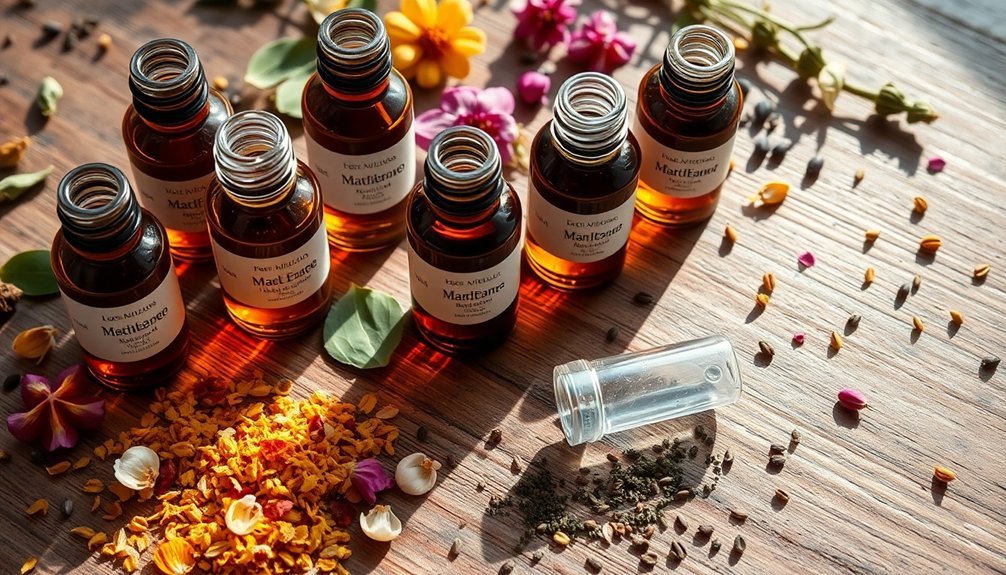
Creating a successful botanical musk blend requires systematic testing and careful adjustments to achieve the perfect balance of notes. You'll need to start by testing small amounts of each ingredient at 5-10% dilution in EtOH, using clean glass vials or beakers for each trial.
| Testing Phase | Method | Evaluation |
|---|---|---|
| Initial Blend | Smelling strips | Immediate scent profile |
| Skin Test | Apply to wrist | Evolution over time |
| Refinement | Adjust ratios | Balance of notes |
| Final Check | Multiple testers | Overall impression |
Document each trial carefully, noting the proportions and resulting scent characteristics. Test your blend throughout the day to guarantee it maintains the desired intensity and character. Store your samples in a cool, dark place and revisit them periodically to observe how they mature and develop over time.
Frequently Asked Questions
How Long Does Botanical Musk Last on Skin Compared to Synthetic Versions?
You'll find botanical musk typically lasts 4-6 hours on your skin, while synthetic musk can persist for several days. That's because synthetic versions are specifically designed for extended longevity and stronger projection.
Can I Sell My Homemade Botanical Musk Blends Commercially?
You'll need proper licenses, IFRA compliance, and safety testing before selling your botanical musk blends. Don't skip registering your business and ensuring all ingredients meet cosmetic regulations for commercial sales.
Why Does My Botanical Musk Smell Different on Different People?
Your botanical musk smells different because everyone's skin chemistry is unique. Your pH levels, natural oils, body temperature, and genetic makeup all interact differently with the fragrance compounds, creating personal scent variations.
Are Botanical Musks Safe for Pregnant Women to Use?
You can safely use botanical musks during pregnancy. Unlike synthetic musks that can pose risks, botanical alternatives don't accumulate in your body or interfere with hormones. They're a natural, safer choice for expectant mothers.
Can Botanical Musks Trigger Allergic Reactions in People Sensitive to Natural Fragrances?
Yes, if you're sensitive to natural fragrances, botanical musks can trigger allergic reactions. You might experience skin irritation, rashes, or itching. It's wise to do a patch test before using them.
In Summary
You've now mastered the basics of creating botanical musk substitutes at home. Remember to keep detailed notes of your successful formulations, always follow safety protocols, and continue experimenting with different botanical combinations. Start small, test thoroughly, and trust your nose. Whether you're crafting personal fragrances or developing signature blends, your natural musk alternatives will evolve as you gain experience.

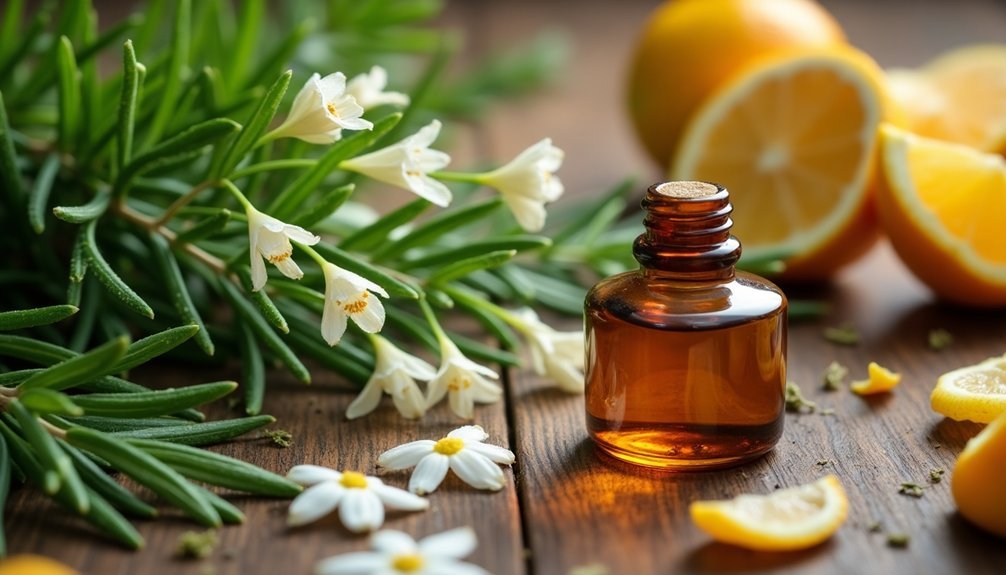



Leave a Reply